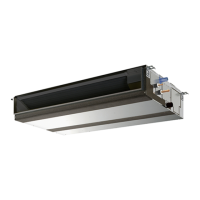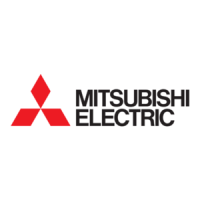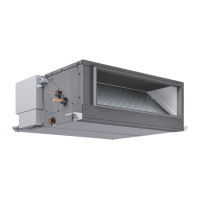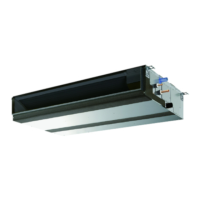14
en
• Be sure to use specified wires for connections and ensure no external force is imparted to terminal connections. If connections are not fixed firmly, heating or
fire may result.
• Be sure to use the appropriate type of overcurrent protection switch. Note that generated overcurrent may include some amount of direct current.
• Some installation sites may require attachment of an earth leakage breaker for the inverter. If no earth leakage breaker is installed, there is a danger of electric
shock.
• Do not use anything other than the correct capacity breaker and fuse. Using fuse, wire or copper wire with too large capacity may cause a risk of malfunction
or fire.
Notes:
• This device is intended for the connection to a power supply system with a maximum permissible system impedance (Refer to IEC61000-3-3.) at the interface
point (power service box) of the user’s supply.
• The user must ensure that this device is connected only to a power supply system which fulfils the requirement above.
If necessary, the user can ask the public power supply company for the system impedance at the interface point.
9.2. Connecting remote controller, indoor and
outdoor transmission cables
• Connect indoor unit TB5 and outdoor unit TB3. (Non-polarized 2-wire)
The “S” on indoor unit TB5 is a shielding wire connection. For specifications
about the connecting cables, refer to the outdoor unit installation manual.
• Install a remote controller following the manual supplied with the remote
controller.
• Connect the “1” and “2” on indoor unit TB15 to a MA remote controller. (Non-
polarized 2-wire)
• Connect the “M1” and “M2” on indoor unit TB5 to a M-NET remote controller.
(Non-polarized 2-wire)
• Connect the remote controller’s transmission cable within 10 m using a 0.75 mm
2
core cable. If the distance is more than 10 m, use a 1.25 mm
2
junction cable.
[Fig. 9.2.1] (P.5) MA Remote controller
[Fig. 9.2.2] (P.5) M-NET Remote controller
• DC 9 to 13 V between 1 and 2 (MA remote controller)
• DC 24 to 30 V between M1 and M2 (M-NET remote controller)
[Fig. 9.2.3] (P.6) MA Remote controller
[Fig. 9.2.4] (P.6) M-NET Remote controller
• The MA remote controller and the M-NET remote controller cannot be used at
the same time or interchangeably.
Install wiring so that it is not tight and under tension. Wiring under tension
may break, or overheat and burn.
9.3. Connecting electrical connections
Please identify the model name of the operation manual attached on the terminal
box cover with that shown on the rating name plate.
1. Remove the screw (1pc) holding the cover to dismount the cover.
[Fig. 9.3.1] (P.6)
2. Open knockout holes
(Recommend to use a screwdriver or the like for this work.)
[Fig. 9.3.2] (P.6)
3. Fix power source wiring to terminal box by using buffer bushing for tensile
force. (PG connection or the like.) Connect transmission wiring to transmission
terminal block through the knockout hole of terminal box using ordinary
bushing.
[Fig. 9.3.3] (P.6)
4. Connect the power source, Earth, transmission and remote controller wiring.
The dismounting of the terminal box is not needed.
[Fig. 9.3.4] (P.6)
[Shield wire connection]
[Fig. 9.3.5] (P.6)
5. After wiring is complete, make sure again that there is no slack on the
connections, and attach the cover onto the terminal box in the reverse order of
removal.
Notes:
• Do not pinch the cables or wires when attaching the terminal box cover.
Doing so may cause a risk of disconnection.
• When accommodating the terminal box, make sure that the connectors on
the box side are not removed. If removed, it cannot operate normally.
9.4. External I/O specifications
1. Wiring should be covered by insulation tube with supplementary
insulation.
2. Use relays or switches with IEC or equivalent standard.
3. The electric strength between accessible parts and control circuit should
have 2750 V or more.
A Terminal block for indoor transmission cable
B Terminal block for outdoor transmission cable
C Remote controller
A Non-polarized B TB15
C Remote Controller D TB5
A Screw holding cover (1pc) B Cover
C Term in al bo x D Knockout hole
E Remove
F Use PG bushing to keep the weight of the cable and external force from being
applied to the power supply terminal connector. Use a cable tie to secure the cable.
G Power source wiring H Use ordinary bushing
I Transmission wiring
J Terminal block for power source
K Terminal block for indoor transmission
L Terminal block for remote controller
A Terminal block B Round terminal
C Shield wire
D The earth wire from two cables are connected together to the S terminal. (Dead
-end
connection)
E Insulation tape (To keep the earth wire of the shielded cable from coming in contact
with the transmission terminal)
01_KJ79P971H02_en.book 14 ページ 2022年7月5日 火曜日 午前11時38分
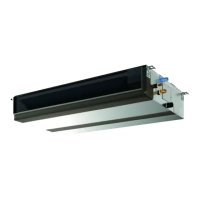
